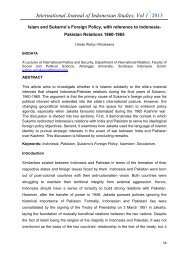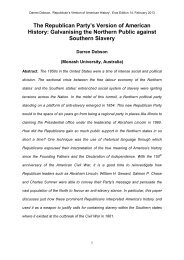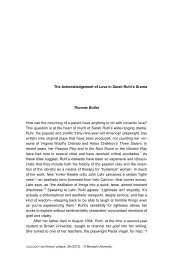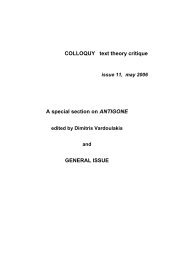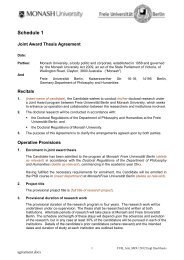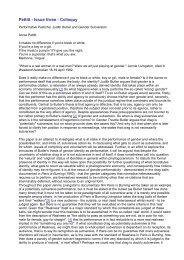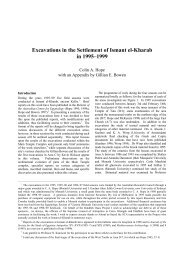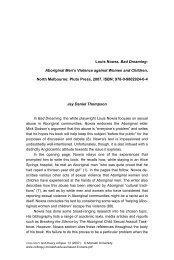Carlo Salzani. Constellations of Reading: Walter Benjamin in
Carlo Salzani. Constellations of Reading: Walter Benjamin in
Carlo Salzani. Constellations of Reading: Walter Benjamin in
You also want an ePaper? Increase the reach of your titles
YUMPU automatically turns print PDFs into web optimized ePapers that Google loves.
<strong>Carlo</strong> <strong>Salzani</strong>. <strong>Constellations</strong> <strong>of</strong> <strong>Read<strong>in</strong>g</strong>: <strong>Walter</strong><strong>Benjam<strong>in</strong></strong> <strong>in</strong> Figures <strong>of</strong> Actuality.Bern: Peter Lang, 2009.ISBN: 9783039118601David Blencowe<strong>Salzani</strong>’s monograph was orig<strong>in</strong>ally his PhD dissertation, which he completedat the Centre for Comparative Literature and Cultural Studies atMonash University, Australia. His topic is em<strong>in</strong>ently suited to the field. <strong>Salzani</strong>actualises four figures that appear <strong>in</strong> <strong>Walter</strong> <strong>Benjam<strong>in</strong></strong>’s scattered corpus:the flâneur, the detective, the prostitute, and the ragpicker. <strong>Salzani</strong>’s<strong>in</strong>tention is to <strong>in</strong>voke the spirit <strong>of</strong> <strong>Benjam<strong>in</strong></strong>ian criticism, but not to ape it. Hedevotes a chapter to each <strong>of</strong> the figures, and the chapters are divided <strong>in</strong>totwo parts; the first reconstructs the figure under consideration from disparatetexts by <strong>Benjam<strong>in</strong></strong>, while the second <strong>in</strong>troduces a contemporary, <strong>of</strong>tenpostmodern portrayal <strong>of</strong> the same figure. These are the flâneur <strong>in</strong> JuanGoytisolo’s Landscapes after the Battle (1982), the detective <strong>in</strong> Paul Auster’sNew York Trilogy (1987), the prostitute <strong>in</strong> Dacia Mara<strong>in</strong>i’s Dialogue betweena Prostitute and Her Client (1973), and the ragpicker <strong>in</strong> Mudrooroo’sThe Mudrooroo/Müller Project (1993). The diverg<strong>in</strong>g renditions are brought<strong>in</strong>to a constellation with one another, a term <strong>Salzani</strong> draws straight from<strong>Benjam<strong>in</strong></strong>’s Trauerspiel book, so that the past is productively juxtaposedwith the present, allow<strong>in</strong>g the actuality <strong>of</strong> the figure to be read.COLLOQUY text theory critique 19 (2010). © Monash University.www.colloquy.monash.edu.au/issue19/salzani.pdf
108<strong>Carlo</strong> <strong>Salzani</strong> ░<strong>Salzani</strong> is quick to add a caveat to his approach, however. He assuresus that his choice <strong>of</strong> figures is not representative <strong>of</strong> <strong>Benjam<strong>in</strong></strong>’s work, whichis <strong>of</strong> course full <strong>of</strong> many more. <strong>Salzani</strong>’s selection is, rather, “very personaland subjective” (33), as is his choice <strong>of</strong> contemporary texts to which hecompares them. This all appears as it should be when trac<strong>in</strong>g constellations,an image which itself connotes the caprice <strong>of</strong> <strong>in</strong>dividual fancy, whenstars are connected <strong>in</strong>to a mean<strong>in</strong>gful relation <strong>in</strong> the night sky, even thoughthey are <strong>in</strong> fact immeasurably distant from one another. <strong>Constellations</strong>creams perspectival f<strong>in</strong>itude on the face <strong>of</strong> it. One <strong>of</strong> <strong>Salzani</strong>’s great serviceswith his book is to rem<strong>in</strong>d us that <strong>Benjam<strong>in</strong></strong> is resolutely antisubjective.It is this po<strong>in</strong>t that is ignored by the postmodernists who seek toclaim <strong>Benjam<strong>in</strong></strong> as one <strong>of</strong> their own, as a precursor, truly a man ahead <strong>of</strong>his time. Paul de Man is mentioned on this score repeatedly.Those who do make this mistake tend to fixate on the destructive aspect<strong>of</strong> <strong>Benjam<strong>in</strong></strong>ian criticism, without acknowledg<strong>in</strong>g its constructive corollary.In relation to historiography, the <strong>Benjam<strong>in</strong></strong>ian critic must first blast outhistorical phenomena from the fictive cont<strong>in</strong>uum that has been fabricatedby the victors. But after this dramatic event, which can be characterised asapocalyptically messianic and even nihilistic, the materialist historian behaveslike the ragpicker. The ragpicker <strong>in</strong> literature (and <strong>in</strong> the reality <strong>of</strong> Parisiansqualor dur<strong>in</strong>g the n<strong>in</strong>eteenth and early twentieth centuries) wandersthe city streets at night, cart <strong>in</strong> tow, sift<strong>in</strong>g through the trash and detritus <strong>of</strong>modernity <strong>in</strong> order to salvage some vestiges <strong>of</strong> value, which might later besold on for a meagre pr<strong>of</strong>it. Analogously, <strong>Benjam<strong>in</strong></strong>’s materialist historianseeks out the newly liberated fragment from the rubble <strong>of</strong> history, us<strong>in</strong>g it toconstruct a dialectical image. <strong>Salzani</strong> rightly flags the “oxymoron” (249) <strong>of</strong> adialectical image as highly problematic <strong>in</strong> <strong>Benjam<strong>in</strong></strong>ian scholarship. It is aterm that appears <strong>in</strong> the <strong>in</strong>complete Arcades Project, but never atta<strong>in</strong>s“term<strong>in</strong>ological consistency” (33) so that it must rema<strong>in</strong> someth<strong>in</strong>g <strong>of</strong> asuggestive mystery. Nevertheless, <strong>Salzani</strong> argues that whatever else thedialectical image entails, it carries with it a strong whiff <strong>of</strong> necessity ratherthan cont<strong>in</strong>gency.The materialist historian as ragpicker does not seize upon the spoils <strong>of</strong>history and rearrange them <strong>in</strong> an arbitrary way, so as to create constellativemontages <strong>of</strong> temporality that are as shock<strong>in</strong>g and estrang<strong>in</strong>g as they aredeeply subjective, and thus always contestable. Rather, <strong>Benjam<strong>in</strong></strong> impliesthat there is a “historical <strong>in</strong>dex” that guides the materialist, that after the obscur<strong>in</strong>geffects <strong>of</strong> false consciousness have been swept away by the destructivecritical act, the truth content <strong>of</strong> historical phenomena will be revealed.The truth is the recognition that the present has been <strong>in</strong>tended bythe past, that previous missed possibilities may be redeemed <strong>in</strong> the now.
░ <strong>Constellations</strong> <strong>of</strong> <strong>Read<strong>in</strong>g</strong> 109The materialist historian must only be “attentive” (212) to such <strong>in</strong>sights,seem<strong>in</strong>gly passive after the destructive phase so as to avoid the contam<strong>in</strong>ants<strong>of</strong> subjectivity and theory. It is difficult not to be disappo<strong>in</strong>ted whenthe constructive side <strong>of</strong> <strong>Benjam<strong>in</strong></strong>’s methodology is put so baldly, and although<strong>Salzani</strong>’s account is more nuanced than m<strong>in</strong>e, he does not shyaway from <strong>in</strong>dicat<strong>in</strong>g the limitations and failures <strong>of</strong> <strong>Benjam<strong>in</strong></strong>’s project.Indeed, this is the strength <strong>of</strong> the ragpicker chapter, the standout <strong>of</strong>the book, and which reaches its apotheosis when <strong>Salzani</strong> <strong>in</strong>troduces AustralianIndigenous historiography via The Mudrooroo/Müller Project. Inmarked contrast to <strong>Benjam<strong>in</strong></strong>, the Indigenous historian as ragpicker doesnot downplay his or her subjectivity, but <strong>in</strong>stead openly embraces it as apolitical gesture. Nevertheless, there are echoes <strong>of</strong> <strong>Benjam<strong>in</strong></strong> here, evenamongst the notable divergences, and <strong>Salzani</strong> br<strong>in</strong>gs them forth both <strong>in</strong>highly compell<strong>in</strong>g and illum<strong>in</strong>at<strong>in</strong>g fashion. By tell<strong>in</strong>g his or her own story,the Indigenous historian “claims the right <strong>of</strong> the dispossessed to reappropriatetheir history,” contest<strong>in</strong>g the methods <strong>of</strong> its preservation and transmition,and thereby reiterat<strong>in</strong>g “<strong>Benjam<strong>in</strong></strong>’s claim <strong>of</strong> the superiority <strong>of</strong> polticsover history” (237). However, the false cont<strong>in</strong>uum <strong>of</strong> colonial history is disruptedso that the “mythic cont<strong>in</strong>uum” <strong>of</strong> the Dreamtime may be re-affirmed(233), a goal that not only jars with <strong>Benjam<strong>in</strong></strong>’s extreme suspicion <strong>of</strong> “cont<strong>in</strong>uums,”but which also seems <strong>in</strong>compatible with postmodernity’s disavowal<strong>of</strong> all “meta-narratives.” <strong>Salzani</strong> clearly favours Mudrooroo’s approach,but he also th<strong>in</strong>ks that <strong>Benjam<strong>in</strong></strong> can help to <strong>in</strong>form such an endeavour.This cannot occur if <strong>Benjam<strong>in</strong></strong>’s method is slavishly adopted, butonly by “mortify<strong>in</strong>g, re-assembl<strong>in</strong>g, and thus actualis<strong>in</strong>g his thought” (237).We can see why <strong>Salzani</strong> refuses to construct dialectical images <strong>of</strong> hisown. They are deeply embedded with<strong>in</strong> the modernist aesthetics <strong>of</strong> <strong>Benjam<strong>in</strong></strong>’stime, but are also the product <strong>of</strong> an underhand trick. They imply a“historical <strong>in</strong>dex,” the “<strong>in</strong>telligent choice” <strong>of</strong> the ragpicker, which, although itis meant to subsitute theory with method, <strong>in</strong> the end conceals a theory, andconsequently a subjective <strong>in</strong>tention. This theory is theology, which is notkept out <strong>of</strong> sight because <strong>of</strong> its disfigurement, like the chess-play<strong>in</strong>g,hunchbacked dwarf, but “because it would betray the subjectivity <strong>of</strong> the assemblerand thereby disavow the objectivity <strong>of</strong> the construction” (230). <strong>Salzani</strong>leaves us with the <strong>in</strong>escapable conclusion that the dialectical image,for all its mystique, is not actual. As for the other <strong>Benjam<strong>in</strong></strong>ian figures ondisplay, some fare better than others. The detective is shown to be the politicaloutgrowth <strong>of</strong> the otherwise co-opted flâneur. The detective alsoserves as a model for the historical materialist, and is a mile away fromAuster’s later portrayal <strong>of</strong> the “metaphysical detective,” who, hav<strong>in</strong>g givenup on the futile search for existential and political mean<strong>in</strong>g <strong>in</strong> the world,
110<strong>Carlo</strong> <strong>Salzani</strong> ░turns his gaze <strong>in</strong>ward, <strong>in</strong>dulg<strong>in</strong>g <strong>in</strong> what <strong>Salzani</strong> derides as a narcissisticsearch for self-identity. <strong>Benjam<strong>in</strong></strong>’s use <strong>of</strong> the prostitute as an allegory <strong>of</strong>the fetishised commodity comes <strong>in</strong> for rougher treatment. When placednext to Mara<strong>in</strong>i’s more <strong>in</strong>dignant account <strong>of</strong> a prostitute’s lot, <strong>Benjam<strong>in</strong></strong>comes <strong>of</strong>f not only as a latent sexist, but as demonstrat<strong>in</strong>g an uncomprehend<strong>in</strong>g<strong>in</strong>sensitivity by romanticis<strong>in</strong>g these figures <strong>of</strong> the powerless andthe exploited, an act which is itself phantasmagoric.<strong>Salzani</strong>’s book is not only a welcome contribution to <strong>Benjam<strong>in</strong></strong>ianscholarship, but is also a laudable study <strong>in</strong> comparative literature. It ishighly recommended.Monash Universitydwble11@fastmail.fm



